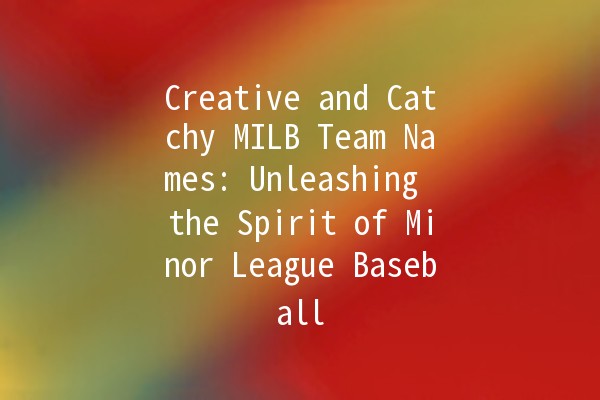Minor League Baseball (MiLB) has long been a cherished part of American sports culture. Each team in the MiLB brings its unique flavor, often reflected in its name. Team names not only serve as points of identity but also encapsulate the local culture, history, and sense of fun that define each community. In this article, we'll delve into the creativity behind MiLB team names and explore techniques for generating inspiring and engaging names that resonate with fans and players alike. Here, we share five practical tips to help aspiring MiLB teams craft names that capture their essence.
Understanding the Importance of a Team Name
A team's name is more than just a title; it’s a brand that needs to connect with the audience it serves. A clever, fun, or relevant team name can enhance fan engagement, create a unique marketing position, and foster a sense of belonging among community members. By analyzing existing names and historical naming conventions, future teams can forge names that are both unique and resonant.
Utilizing local culture and historical references can be a goldmine when creating a team name. Consider what makes the area unique – whether it’s local wildlife, historical figures, or wellknown traditions.
Example:
The Altoona Curve, named after the famous curved railroad tracks that run through the area, connects the team with a vital aspect of its local history. By tapping into local lore, teams can create a sense of pride among fans.
Practical Application:
Research significant historical events, landmarks, or figures specific to your region.

Conduct surveys or gather input from community members to identify what they feel represents them best.
Combine these inspirations with common sports themes – animals, actions, or local descriptors – to formulate potential names.
Humor is a great way to make a name memorable and entertaining. A whimsical name can evoke a sense of laughter and joy, making fans more likely to return.
Example:
The Portland Pickles and the Burlington Sock Puppets
Practical Application:
Brainstorm puns or plays on words related to local features or sports language.
Consider how the sound and rhythm of the name come across when announced at games.
Test your ideas with focus groups to gauge reactions and refine your concepts based on feedback.
Incorporating animals or elements from nature can create an instantly recognizable image for a team name. Animals can symbolize local fauna or evoke specific traits associated with them, such as strength, speed, or agility.
Example:
The Akron RubberDucks utilize the imagery of rubber ducks combined with a nod to their city’s rubber industry heritage, leading to a fun and memorable identity.
Practical Application:
Compile a list of local wildlife, plants, or natural features.
Choose animals that carry significant meaning or resonate emotionally with the community.
Pair animal names with action words or adjectives to create dynamic team names, like “Stingers” or “Blazers”.
Frontloading the fan experience in the naming process can transition a mere team into a source of pride for the community. Fans should feel a connection to the name as something they can rally behind and cheer for.
Example:
The Fresno Grizzlies
Practical Application:
Engage with fans through social media campaigns asking for suggestions or votes on potential names.
Create a sense of ownership by allowing fans to contribute to merchandise designs or team mascots based on the name.
Develop taglines or slogans that amplify the feelings associated with the name; for instance, a team named after a local creature could adopt a motto touching on protection of nature.
While it’s important to stay true to community ethics and history, flexibility is crucial in the creative process. Sometimes an unexpected name resonates better than anticipated.
Example:
The Brooklyn Cyclones
Practical Application:
Host multiple brainstorming sessions with varied groups, including staff, fans, and even kids, to generate diverse ideas.
Experiment with multiple combinations of words and sounds to find the most resonant option.
Create a shortlist of names and conduct voting within the community to determine which resonates best.
Frequently Asked Questions
When naming a MiLB team, it's essential to consider community heritage, local culture, marketability, and memorability. The name should embody both the spirit of the team and its community connection.
Involving the community in the naming process fosters ownership and pride among fans and local residents. It creates a sense of connection that translates into higher support and engagement.
Absolutely! Humor can create a memorable identity, making it more likely that fans will share and promote the team. Fun names can become part of the cultural vernacular, leading to increased visibility.
Yes! Ideally, the name should complement the mascot and logo for coherent branding. A related name can enhance the visual representation of the team, leading to better marketing opportunities.
Yes, it’s essential to check for trademarked names to avoid legal issues. Conduct thorough research to ensure the chosen name is not used by another team or brand and can be legally registered.
Changing a team name can be beneficial if it doesn’t resonate well with the community or doesn’t effectively represent the team. However, such changes should be made thoughtfully, with ample fan involvement.
In summary, crafting a catchy and engaging MiLB team name is a significant endeavor that requires a blend of creativity, cultural reflection, and community interaction. By following these practical tips and fostering an environment for innovation, teams can develop names that will resonate with fans and strengthen community bonds, ensuring a vibrant and enduring team identity.